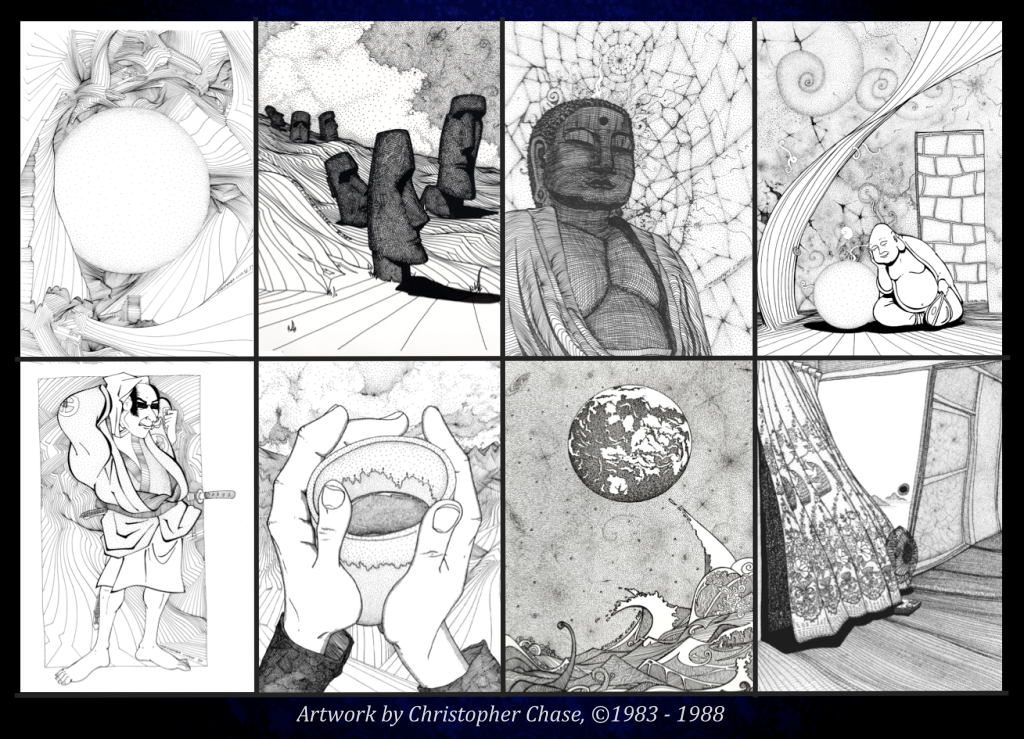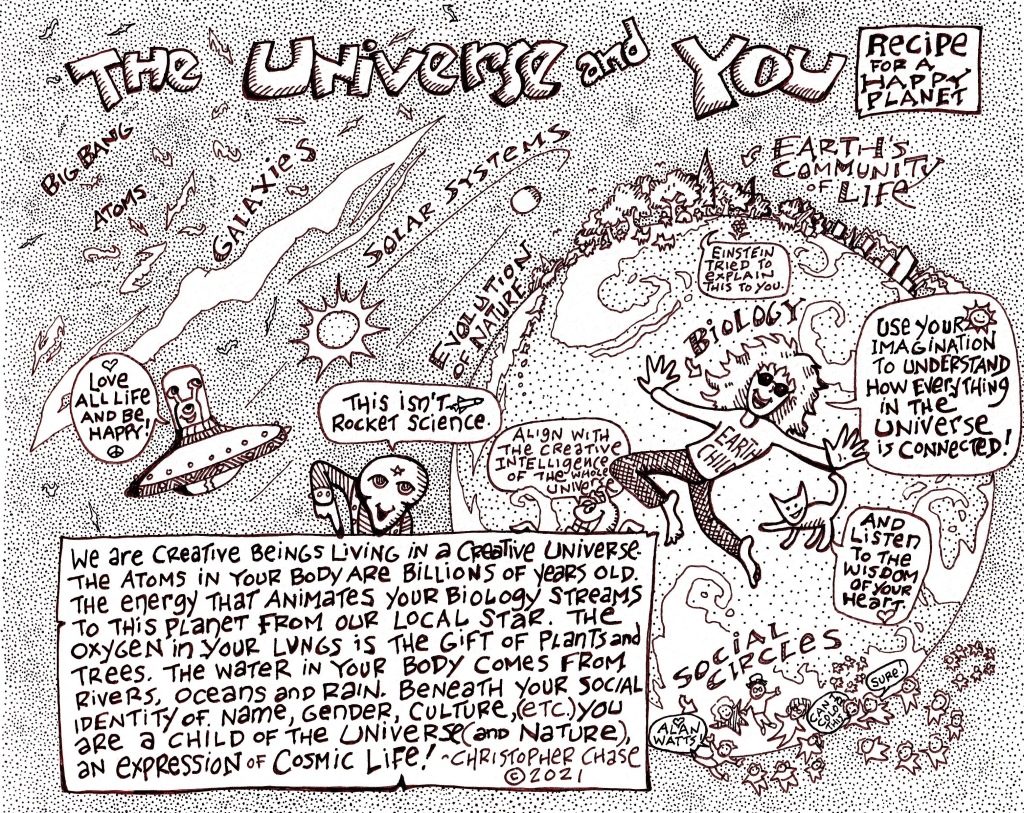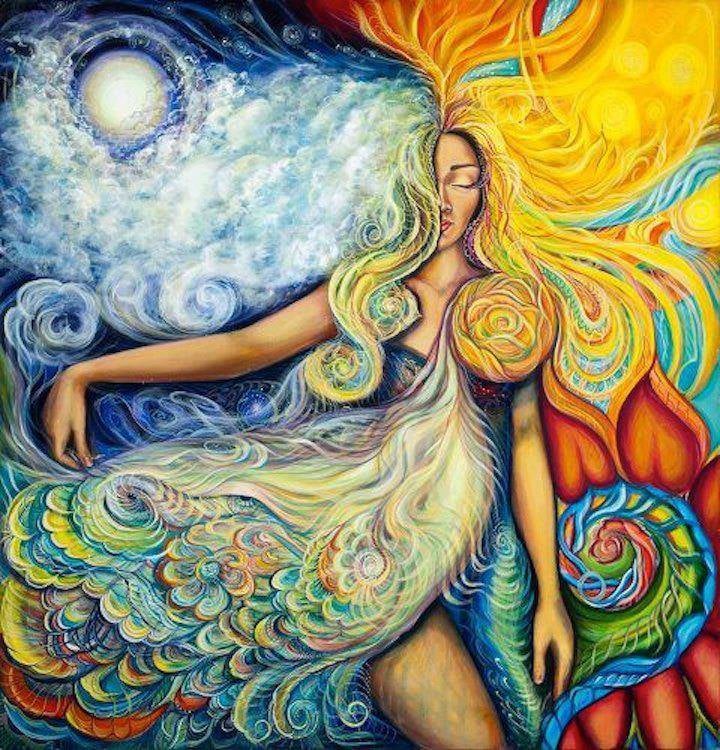“Life is sacred, life is art. Be mindful. See the beauty that exists everywhere, the creative mystery that we are. Be aware of your presence and connection to everything. Know that behind your social persona and cultural identity you are the child of a Creative Cosmos.”

Here below are high quality reproductions of some of the drawings that I have produced over the last 40 years, as well as some background on the meaning and inspiration behind each work. Please feel free to download, print out and/or share with others, no payment required. The originals were mostly about 10 x 14 inches (26 X 35 cm) in size. My only request is that you do not sell them or publish without contacting me first.
“Principles for the development of a complete mind: Study the science of art. Study the art of science. Develop your senses- especially learn how to see. Realize that everything connects to everything else.” ―Leonardo da Vinci
The view I try to share with my drawings is that we are all works of universal cosmic art. From science we now know that everything within and around us is made of atoms that are billions of years old (which is what the dots represent in my drawings). Many other recurring shapes and patterns (such as spheres and spirals) can be seen, if we observe Nature carefully.
In the 1980s, while living in Japan, I began to experience my life more deeply and tried to express this vision (of the unity, interconnectedness, beauty and sacredness of everything) in my drawings. These works were strongly influenced by Taoism, Zen, meditation and experiences of mindfulness. Since the 1990s the focus of my drawings shifted to education and systems thinking, but the deeper “truth” or meaning being expressed is the same, that everything is connected and we live in a creative Universe that is itself a work of cosmic art.
This is where the artist’s vision can blend with science, highlighting the deep sacred mystery found in the shapes, patterns and cycles of our Universe. Nature is more like a flowing living symphony than a material “thing.” And everything is connected, everything is energy. Van Gogh expressed this beautifully with his art, William Blake with poetry, and Einstein with science, so there is nothing really “new” that I am trying to communicate.
Mystical traditions and individuals have been expressing this understanding for centuries. Life is sacred, life is art. Be mindful. See the beauty that exists everywhere, the creative mystery that we are. Be aware of your presence and connection to everything. Know that behind your social persona and cultural identity you are the child of a Creative Cosmos.
For anyone interested, I have written more about these ideas here: Zen & the Art of Living Deeply, Paradigms are Made for Shifting, How We Participate in the Creative Life of the Universe and The Universe is One Harmonious Whole. We have a group on Facebook Artists of the New Cosmology that all are welcome to join.
My feeling is that humans often overcomplicate things. Truth and wisdom are simple, I think. Peace and love arise naturally when we connect with the Universe around us and Source wisdom within us. Trust the Universe, align with the creative laws of Nature and the deep love within you.
Be happy. Be joyful and creative. Be loving. Keep growing.

The illustrations above and below were both done in the winter of 1983, at the age of 21, during my first year as an exchange student in Japan. I had just learned to meditate, and the sense of calm and quiet of meditation (as well as the experience of living in Japan) profoundly influenced these drawings. I had been drawing since age 3, but had never done anything like these works before. It felt like the creative action was coming from a different consciousness, not the personal me but a deeper universal awareness.
The drawing below was actually done first. I felt the sphere represented the unity and wholeness of our Earth when we step back, while the lines represent the complexity we experience when we come in close. I also felt the drawing was similar to a mother’s womb or egg, representing the hidden creativeness of life within life. The image above has similar meaning, although the plant leaves definitely represent the mysterious beauty of growth.

The next drawing was done about 3 years later, when I returned to Japan to teach on the island of Amakusa, in Kumamoto. This was done in the summer of 1985, I think. I wanted to show how the curtain, walls and tatami floor were part of the Universe, made of atoms (which are made of energy) and always moving. Vincent Van Gogh’s paintings of rooms and starry skies definitely were the inspiration for this, as well as Japanese rock gardens I had visited.

The next drawing was done in the winter of 1986, when I lived in Amakusa, Japan. I had bought the smiling statue of Hotei while visiting a friend in Hong Kong. This is one of my favorite drawings, as the whole work kind of created itself, I felt almost like an observer. I had no pre-set image in my mind. First I drew the statue. Looking at this, it seemed a sphere next to him would be great, like he’s resting on a stone. Then I started to draw the lines, and suddenly at some point my hand just shot up creating the water like structure. I had not thought of that, it just happened.
Then I went back and drew more lines under him, and the idea arose to put in a door. Once the door was there, I drew the stone like shapes, aware these were like a wall, a very human design in contrast to the organic shapes. I see these shapes as also representing the human tendency to compartmentalize. I drew for about 7 hours that first day, finishing everything except for the background. I then spent the next two or three weeks slowly doing the dots and shapes, just listening to music, allowing my hand and eyes to dance together on the paper.

The initial design for this Easter Island drawing below was actually started many years earlier, probably around 1981, before I went to Japan. I had not done the sky or made the heads dark, originally. After returning from Japan in 1986, I looked at the old drawing and immediately sensed how to finish it.

I think this below was also made in 1987, when I was back in New York. I was sitting on my parents’ back porch with a cup of tea in my hands, just staring at the tea cup and realized this would make a beautiful drawing. I call this empty cup principle, in reference to Lao Tsu’s verses (in the Tao Te Ching) about how its the emptiness of a cup or room that makes it useful. The cup I drew was not empty though, so I wanted to represent how the tea had depth, was a part of the cosmos, how the Universe is there in the tea cup. Not symbolically but REALLY (if we think deeply about it). When we drink water, tea or anything, we are drinking the universe in that form. Everything (and everyone) is the Universe, in some form.

This below was drawn after my wife Hiroko and I had moved to California. It was influenced by the waves of Japanese ukiyoe paintings, and a similar drawing an art teacher that I had met in Japan had drawn and showed me, although his drawing was a moon above waves. He also drew with black ink, and gave me some excellent advise, saying to take my time and balance the light areas of drawings with much darker areas.

This below is a drawing of a plant we had in our home in Hayward, California. I drew the plant first, and then let my imagination just dance and have fun with the rest of the work. As mentioned, I would usually listen to music while drawing, and so I tried to represent that also. Like the plant was singing or the atoms around it were singing and dancing, everything moving. Again, influenced by Van Gogh, I wanted to express the deep moving nature of the cosmos.

After 1988, I did not draw many large illustrations such as these anymore. I became a doctoral student at Stanford University, studying education, psychology and child development. The next drawing was made when I worked as a research assistant at a school we were helping, where I assisted a 7th grade science teacher. Her students had studied all the parts of human and plant biology, learned the names of all the parts of cells and ecosystems, but nowhere in their textbooks was a description or explanation on how all these “parts” fit together as a unified whole.
I came in one day and drew this on the blackboard. It’s the first “systems illustration” that I made, showing how our bodies and cells are connected to the plant world and solar system. The students were fascinated by this, they had not realized that we are solar powered, or that their biological systems functioned as a transport system connecting them to Nature and the Universe, so that water, energy, oxygen and other molecules could regenerate our individual lives. This is what the Zen teacher Thich Nhat Hanh describes as awareness of inter-being, using our imaginations to become more conscious of the deep unity and interdependence of everything.

This below was done in 1995, after I had graduated from Stanford and we moved back to Japan. I drew this after a Rolling Stones concert, here in Fukuoka, although the idea originally arose while attending Grateful Dead concerts in California. I wanted to show how everything is connected in both space and time. We are connected back billions of years, to the deep history of our ancestors, cultures and the evolution of both Nature and the Universe. We are also connected spatially, to our communities, nations, civilization, ecosystems and the solar system. As Leonardo da Vinci had said, “Develop your senses- especially learn how to see. Realize that everything connects to everything else.”


The drawing Systems Science (above) was done for my students here in Japan. Everything that exists structurally is a system, embedded in and connected to other systems. I wanted to express the same idea recently and drew this (below). We are all creative expressions of the Universe, it is within us and all around us. My feeling is that by seeing life in this way we can gain a sense of the beauty and mystery of everything, the miracle of our presence here.

So, those are some of my “better” works. Please download and print out (or share) any of these images that you like. If you share on Facebook or SNS and can provide a link to this blog, that would be great, but not necessary.
I have never sold any of my hand drawn illustrations, I still have most of the originals. For me, the “value” of art has nothing to do with money. The value of this work has been found in the creative process and the sharing.
For viewers, the “value” hopefully comes by spending time with the drawings, allowing your consciousness to connect with the images and what they represent. This is true for all artwork, in my opinion. These are to be reflected upon, shared and experienced, not collected as some kind of “investment.”
Just quiet your mind, allow your consciousness and imagination to flow into the work directly, like you would with good music, see and feel whatever arises from that. Think about what the art is saying about the deepness of you and your life, the sacred mystery of everything that surrounds us. Know also that you can connect deeply in this way with anything, any work of art, a flower or friend, the moon, a meal, a landscape or tree.
For anyone interested in diving more deeply into ideas related to systems thinking and the role of imagination and the arts in helping people gain a deeper understanding of the unity and wholeness of the sciences, this below is a presentation that I made on the topic, in the summer of 2021.
Finally, shifting gears a bit, for the last few months I have been experiencing wonderful meditations with audio readings Samaneri Jayasāra has shared on youtube of classic Advaita Vendeta, Dzogchen and Zen teachings. I drew this recently (below), a sketch, of what I have been experiencing while meditating. In the Ribhu Gita, the idea is shared that God/Consciousness, Universe, Nature and our own Consciousness are All ONE. Meditating on the life force and the silent field of awareness within us, our soul consciousness, can be like stepping through a sacred doorway.
But spiritual connection can happen outwardly too, with Nature, family, work, community, art, music, food, everything can be seen and connected with in a more “spiritual” way, even science and society. This is something Taoism and Zen express well. Cause if everything is ONE, everything is made of atoms and energy, then there is nothing that is not a creative expression of the Universe.










